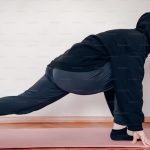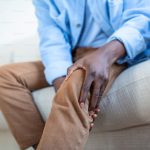I love people watching – I’m a physio, I can’t help it. For me, time waiting for trains is time spent checking out how people stand. Spotting the person with great posture becomes my passion. You know the one who stands tall; elegant, effortless and a delight to watch.
But why don’t we all move that way? And can we change that with yoga?
The Curse of Modern Life
Our bodies are designed to move. And move a lot. Think of the Hunter Gatherer lifestyle of our ancestors. Walking great distances. Reaching and bending to forage for food. Squatting to work by fires. Joints were put through their full range of movement regularly.
In contrast, think of our lives today. Sitting at desks. Sitting to travel. Using chairs, rarely squatting. Static. Hardly moving. All this time spent sitting takes its toll. We get fixed in that position. We gradually become one big slouch ultimately getting pain in that position AND pain when we try to get out of it. Here’s how it happens.
Beautiful Biomechanics
Good posture is so much more than just holding your shoulders back. Looking from the side, someone with good posture has their pelvis balanced over their ankles. Their spine has a little forward curve at the waist (lumbar lordosis); a backward curve between the shoulder blades (thoracic kyphosis); and a small forward curve in the neck (cervical lordosis). Their head is balanced on top of the spinal curves with their chin hovering over their breast bone and their arms hang in line with the body. Perfect!
Now imagine a plumb line (piece of string with a weight on it) held next to their body. The imaginary line it draws is the line of gravity. In good posture the line of gravity passes through the following points:
- tragus of the ear (that fleshy triangle pointing backward into the ear from your cheek)
- just in front of the shoulder joint
- body of the 4th Lumbar vertebra
- hip joint
- knee joint
- just in front of the ankle joint
Every time one segment of the body moves away from that line, something has happened to compensate. Some muscles will have to overwork to hold us in the new position and others will become lazy and waste away. Some soft tissues may get stretched – possibly causing pain – and others will shorten. Short soft tissues limit the range of movement. And before we know it we have poor posture and where posture is poor, pain will follow.
Common problems
Next time you get the chance to people watch, maybe you’ll see some of these common problems:
- Sway back – the hips are swayed forwards of the line of gravity and the body leans back to compensate.
- Anterior pelvic tilt – imaging the pelvis as a seesaw balanced on the hips. Looking from the side, this posture has the front of the pelvis tipped down and the back arched forwards to compensate.
- Flat back – the seesaw pelvis has tipped back and the lumbar spine compensates by reducing the lordosis and flattening.
- Increased thoracic kyphosis – this is the round-shouldered slouched posture of the modern world. Usually comes with increased cervical lordosis and poking chin. Can be combined with any of the above postures in the lower body.
If we regularly move out of these postures and move in the opposite directions then there will be no lasting effects. BUT if we spend too long in these postures and not enough time out of them we get soft tissue changes. Some soft tissues will become longer than ideal while others become tight. Once tissues are tight we have lost the ability to get out of the bad posture. We are effectively stuck there.
At this point, we will feel discomfort from overworked muscles and stretched soft tissues when we stay in the bad posture, as well as from the tight soft tissues when we try to get out of it. It can feel like we can’t win! Not a good place to be…
Yoga is the Solution
There are two clear patterns of soft tissue changes that poor posture can cause. And the good news is that yoga has SOOoooo much to offer to prevent and even reverse these characteristic changes. Here’s where to look:
Upper crossed syndrome – rounded shoulders and poking chin causes –
- short tight muscles and soft tissues over front of chest and shoulders
- weak, long muscles over upper back and back of shoulders
- short, tight muscles and soft tissues over back of neck
- long, weak muscles in front of neck
Lower crossed syndrome – sway back or anterior pelvic tilt posture cause
- long, weak abdominals
- short, tight muscles and soft tissues in lower back
- long, weak glutes
- short, tight soft tissues and muscles in front of hips.
Sound familiar? Want to go from slouch to superb posture? Here are a few of my favourite yoga poses for better posture.
- Tight chest and shoulders – ustrāsana (camel), trikonāsana (triangle), prasaritta padotanāsana C version (wide legged forward fold with hands clasped behind) and dhanurāsana (bow), with all their variations, are great for stretching the front of the chest and shoulders. As well as feeling the stretch in the front, see if you can draw the shoulder blades back and down to add a little strengthening there too.
- Poking chin – focus on tucking the chin back and lengthening the back of the neck in any pose you can. Tadāsana (mountain) and dandāsana (staff) are great places to work on this. Try lengthening the whole spine as you ground down in the pose for added benefit.
- Weak upper back – gently drawing shoulder blades together and towards the waist in tadāsana, trikonāsana and virabhadrāsana (warriors) works nicely to wake up this area. And salabhāsana (can be called locust or boat) in all of its variations is my ‘go to’ pose to strengthen upper back extensors and muscles of the shoulder blade at the same time.
- Short, tight lower back – balāsana (child’s pose) and malāsana (yogi squat) are great ways to stretch the lower back but can challenge to begin with. Don’t be afraid to use props and modifications to access these poses when you are starting out.
- Short, tight front of hips – here you have a lovely range of lunges (high, low and twisted versions) to choose from. In viarabhadrāsana 1 and high lunges, try engaging your glutes on the back leg to help release the hip flexors on that side for that extra lengthening.
- Weak glutes – utkatāsana (chair) engages these beauties but you may have to think about it at first – imagine drawing the upper thighs back and clenching your butt a bit. Focusing on glutes to draw the front leg out in virabhadrasana 1 and 2 to build glutes strength. And all single leg balances need the glutes to work but virabhadrāsana 3 uses them no move in and out of the pose as well as to stabilise the standing leg. Bonus!
- Weak abs – engage the abs by gently drawing lower ribs towards the pelvis in all backbends. Plank and side planks in all modifications and variants work the abs. Hand, head and single leg balances require great core strength when done well and… Actually pretty much every yoga pose I can think of other than savāsana (corpse) engages the abs when done well.
Look Good to Feel Good
The human body has evolved to stand upright in a wonderful arrangement of curves and pivots from top to toe. This arrangement is energy efficient, protects soft tissues and keeps aches and pains at bay. Not only does it look good but it feels good too! Mind and mood both benefit from good posture just as much as our physical body does. Working towards better posture is a great way to look after yourself physically and mentally.
So – could you become that person that I see with beautiful posture, effortlessly gliding through the crowd next time I am people watching? The journey towards better posture can bring so much pleasure and prevent pain. Worth a try? I think so!













